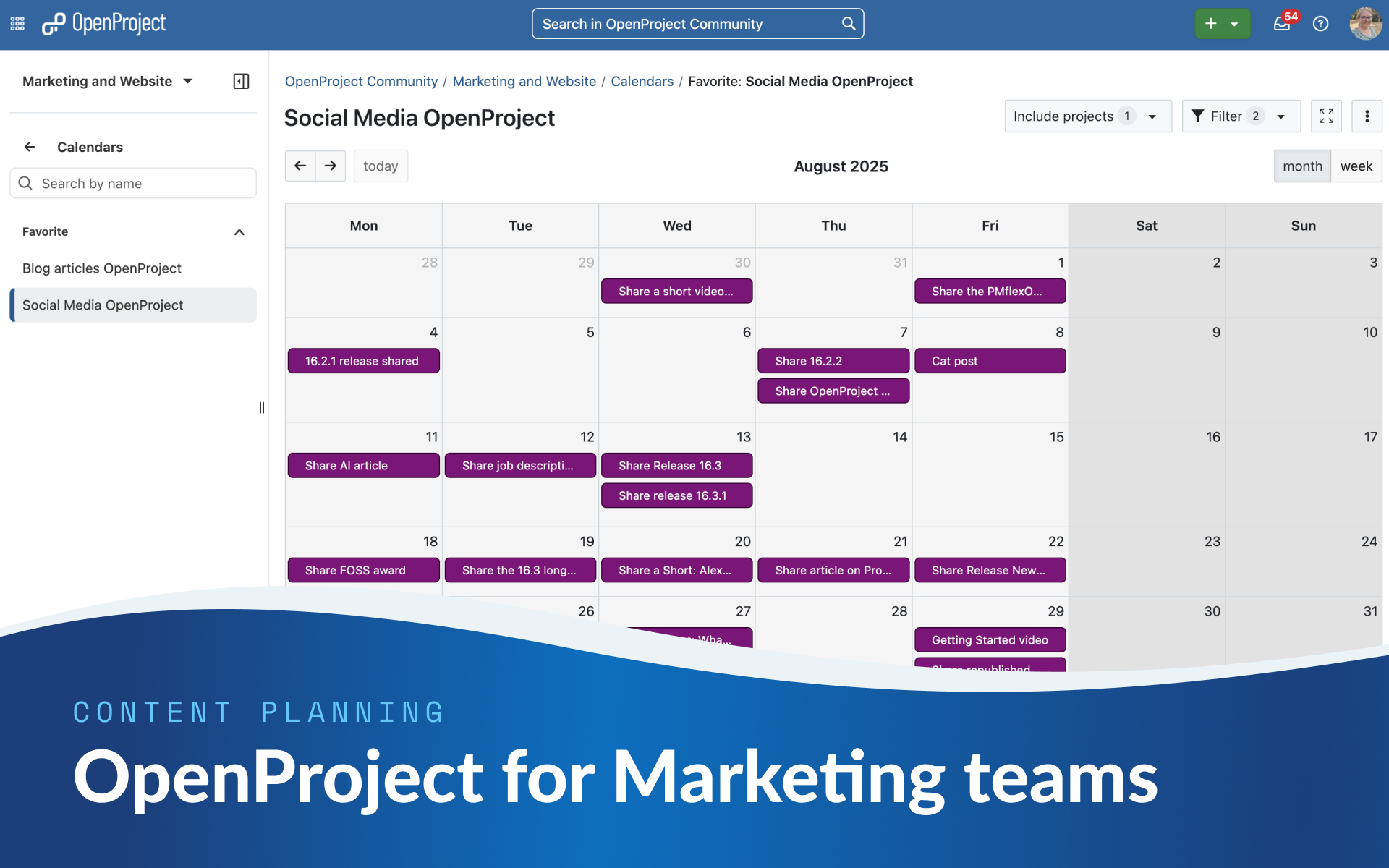
Free content planning tool: Practical tips for marketing teams using OpenProject
Marketing teams, we know your struggles. Your content planning deserves better than sticky notes and scattered tools. Sometimes, all it takes is a smart structure and the right tool to turn chaos into clarity. Customize OpenProject to plan your content efficiently in one place — it’s free, open source, and built for team collaboration. From discussing a new strategy to handing over content pieces for review, manage your marketing work in a clear, precise way. And be the flagship of your organization.
This article gives you tips and practical insights into how we at OpenProject use our own tool: for content planning, social media calendars, campaign coordination, and more.
Looking for a great and low-cost content planning tool?
Especially small marketing teams face challenges like:
- How do we plan and organize our content effectively?
- How can we make it transparent which content still needs review or is ready to be published?
- What should we do with content ideas that aren’t ready to be scheduled yet?
- How can we make sure the whole team has full visibility into content plans and responsibilities?
- How do we coordinate with other departments — like Sales or Product — without endless email threads or lost feedback?
- How can we collaborate with freelancers or external partners without granting access to everything?
And above all: How do we keep everything in one place, without paying for yet another tool?
OpenProject is free and open source
Maybe you’ve already tried to solve these challenges with tools like Trello, Asana, or Notion — but none of them fit your exact workflow? Perhaps they lack transparency, are hard to customize, or simply cost too much?
OpenProject is a powerful alternative to these content and project planning tools. It’s free and open source — which means no licensing fees in the Community edition, full data control, and maximum flexibility. You can tailor your setup to match exactly how your marketing team works.
OpenProject makes it easy to manage all types of content in one place — from blog articles and social posts to videos, designs, and written copy — so your entire planning process stays connected.
It comes with all the essential features for content planning and team collaboration:
- Agile boards to track content status from draft to publication.
- Calendar views to schedule blog posts, campaigns, and social media content.
- Relations between tasks / content pieces (e.g. the social post for a blog article).
- File management and comments to collaborate transparently in one place.
Insights: How to use OpenProject in a marketing team
But let’s get specific: What does OpenProject actually look like when used as a content planning tool? In the following sections, we’ll give you a detailed look into how we — the OpenProject marketing team — use our own software every day. Because we know the struggles of content planning firsthand. And we know exactly how to tailor OpenProject to organize and structure marketing work effectively.
OpenProject gives you a lot of flexibility — but you have to know how to make the most of it.
Content planning with OpenProject
Let’s start with the basics: In OpenProject, everything begins with a “project” — but that doesn’t mean it has to be a classic project with deadlines and deliverables. You can simply create one called “Marketing” and use it as your team’s workspace. Depending on your structure, you can also create sub-projects like Content marketing or Event marketing. If you’re a small team, we recommend starting with just one project, which keeps everything in one place and is easy to manage.
Now it’s time to define your work packages. In OpenProject, work packages are the building blocks and can be of types like task, campaign goal, blog article, or social media post. This is where the flexibility of OpenProject really shines: You define the types that make sense for your marketing work, and you choose the status values that reflect your workflow.
For example, a blog article might move through the following statuses: New → To be scheduled → Scheduled → In progress → Needs review → Closed.
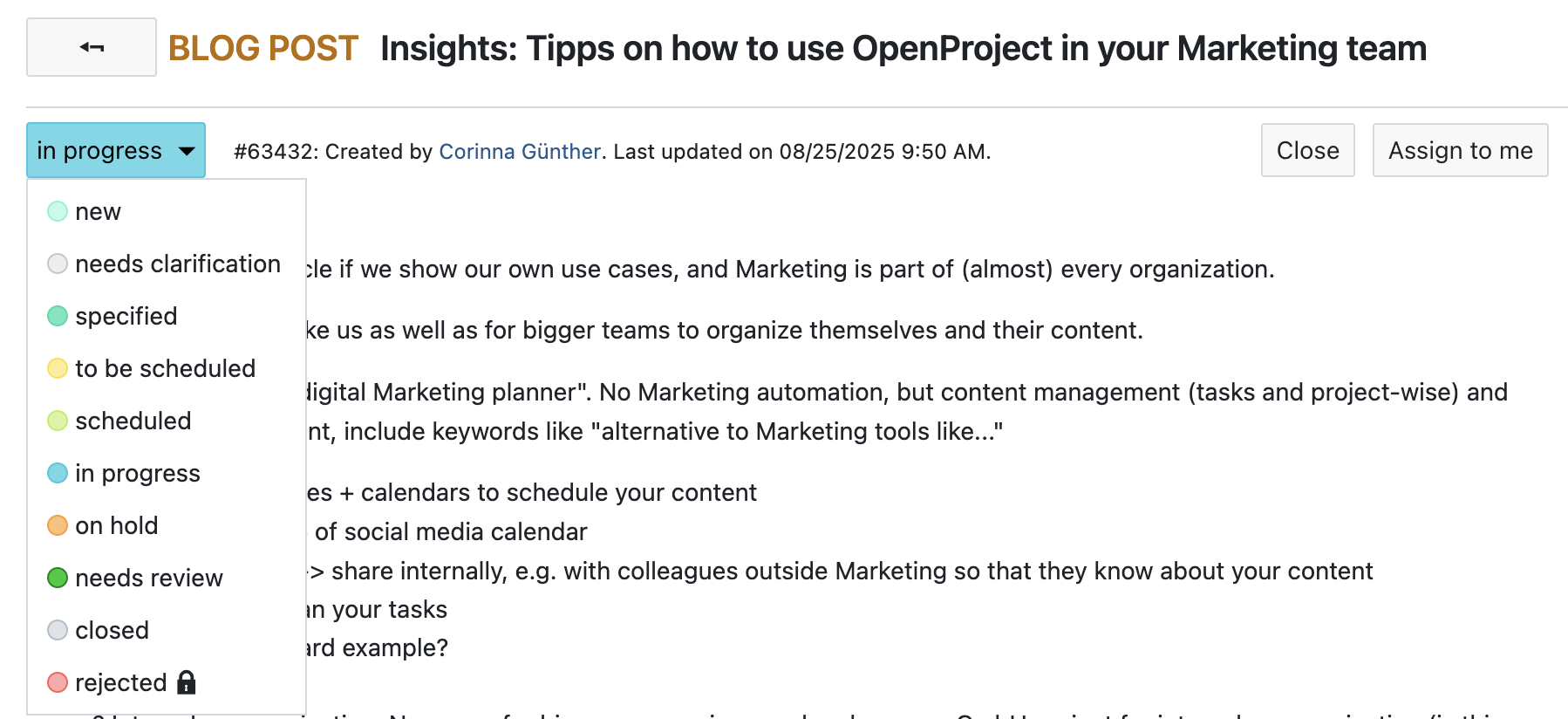
To make your setup even more precise, you can use roles like Assignee and Accountable to clarify responsibilities — for example, who’s currently reviewing a piece and who’s ultimately responsible for delivery. And if your team needs additional information to stay aligned, you can define custom fields to track things like campaign goals, target audiences, or publishing channels. It’s all fully customizable to match your team’s workflow.
Table view or board view — work how your team prefers
In OpenProject, you can work in different views depending on your team’s style:
The Table view shows your content tasks in a familiar spreadsheet-like format. It’s great for bulk editing, filtering, grouping, and customizing columns — like status, finishing date, or assignee.
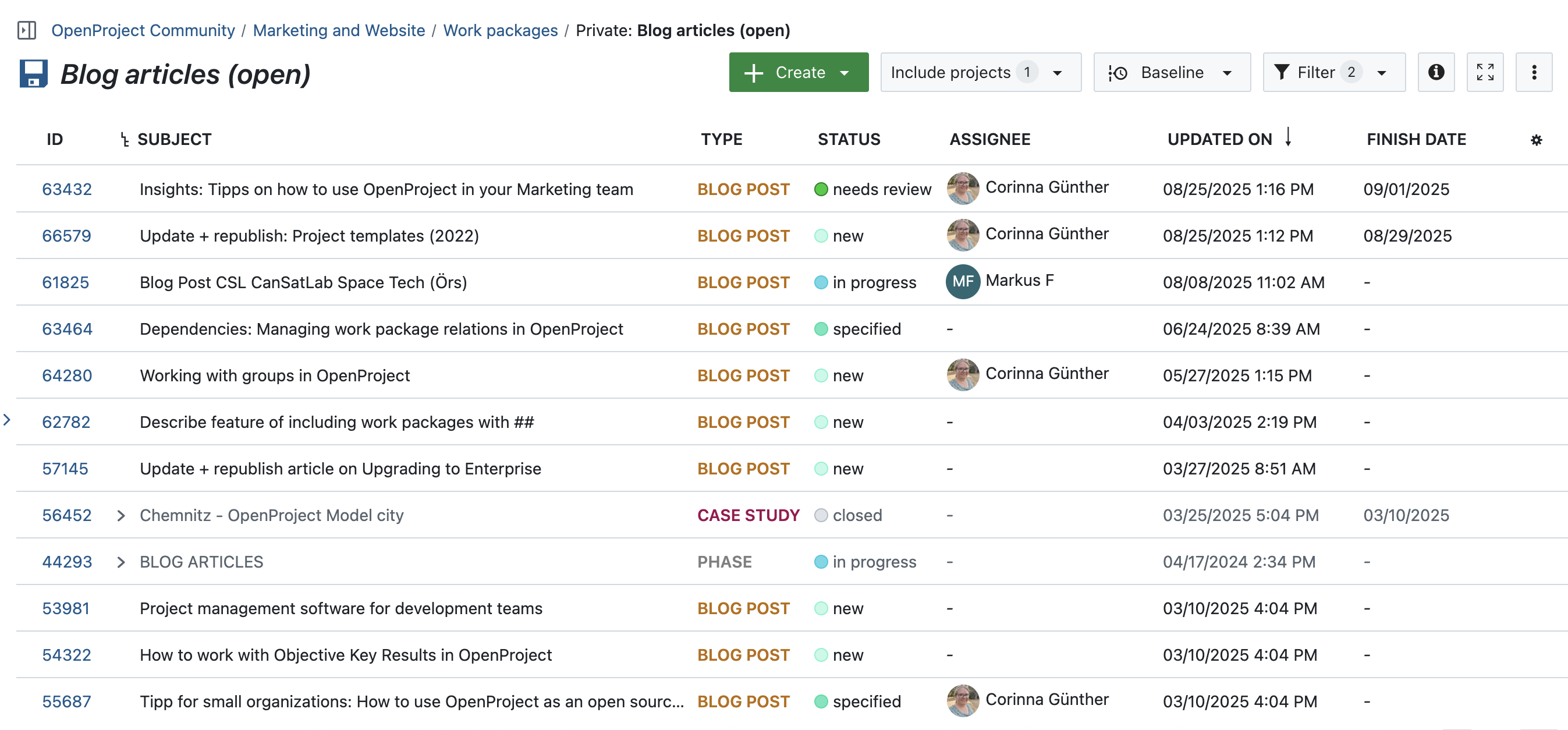
The Board view lets you organize content in an agile Kanban-style layout. It’s perfect for visual planning and drag-and-drop changes between statuses like In progress, Needs review, or Published.
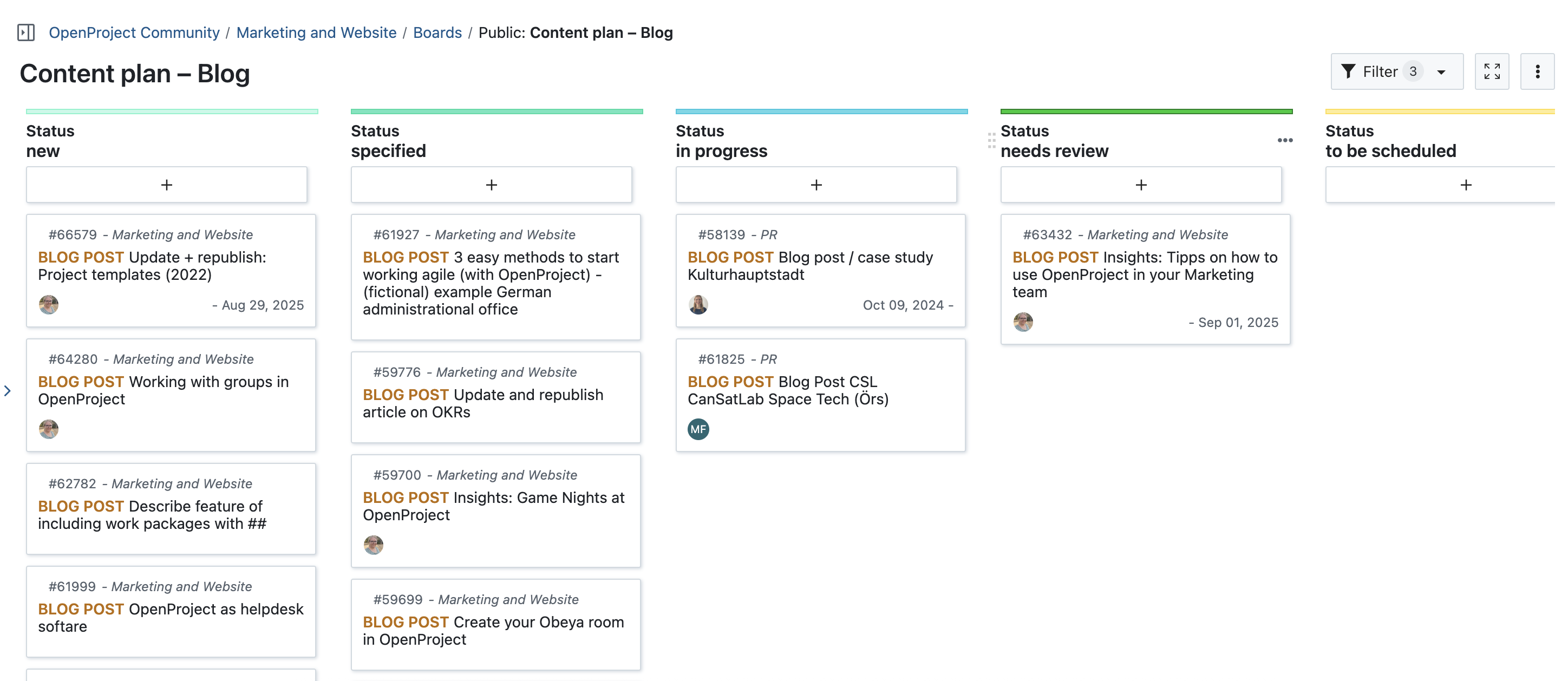
You can switch between views anytime, and every view can be customized to show exactly what your marketing team needs.
With this structure in place, your marketing team is ready to manage all kinds of content workflows, from blog posts to social media management and event planning.
Blog article management
We’ve already given you some insights in our blog article management above. Let’s walk through the full process, from idea to publication.
-
One person comes up with an idea and creates a new work package of type Blog article. They add all their thoughts into the description and @mention their colleagues or team leads in the Activity tab to discuss if and when this idea is ready to follow up on.
-
The mentioned person answers and updates the status from New to To be scheduled. They also assign the work package to the person responsible for writing and publishing.
-
When the article is written, the status is set to Needs review and the assignee is changed to the colleague who will do the review. This makes responsibilities clear at every stage.
-
When the article is ready to be published, a date must be set. If you’ve set up a calendar (by filtering for type blog article), the article will now be shown there.
Here’s an insight into the blog article calendar at OpenProject:
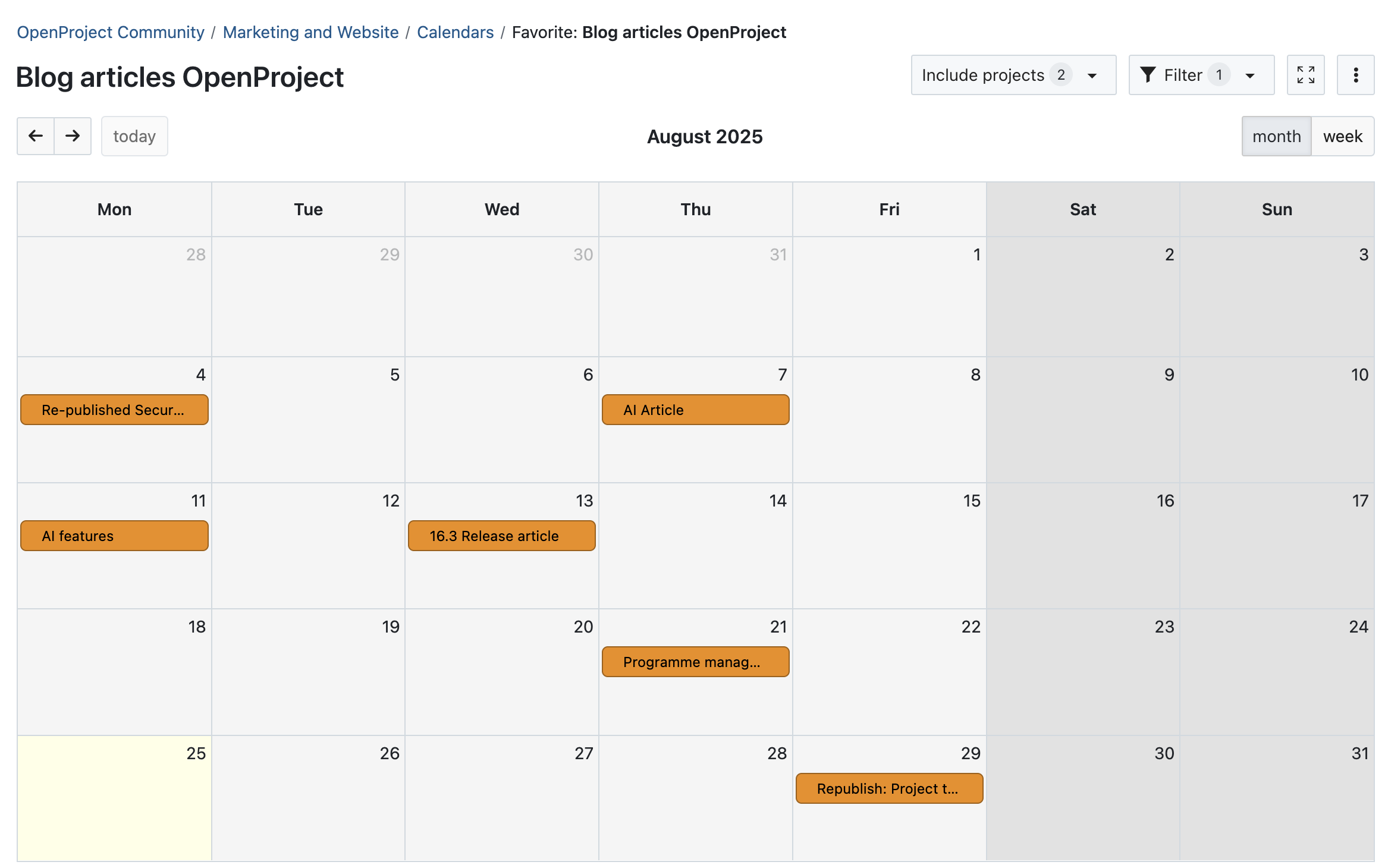
Tip
Subscribe to your OpenProject calendar from your external calendar app. This way, you always see when blog articles are scheduled. This isn’t just helpful for your team, but also for Sales, Support, or others who want a quick overview of upcoming content.
- Once the article is published, the work package is marked as Closed. This removes it from your open work lists, but it still exists for future reference or performance tracking.
Of course, you might now want to share your new content piece for the world to see. To do so, let’s look at how to manage social posts with OpenProject.
Social Media management
Once your content is ready, it’s time to get it out into the world — and social media is usually the next step. With OpenProject, you can plan and coordinate your social media posts just as precisely as your long-form content.
Each social post becomes its own work package. You can set the type to Social media and use custom fields to track channels (e.g. LinkedIn, X/Twitter, Instagram) or campaign tags. This keeps everything structured and filterable.
A typical process might look like this:
- Create a work package of type Social Post for each planned social post. Add the content draft directly into the description or attach a file if needed. Make sure to add a date so that your post will appear in the calendar.
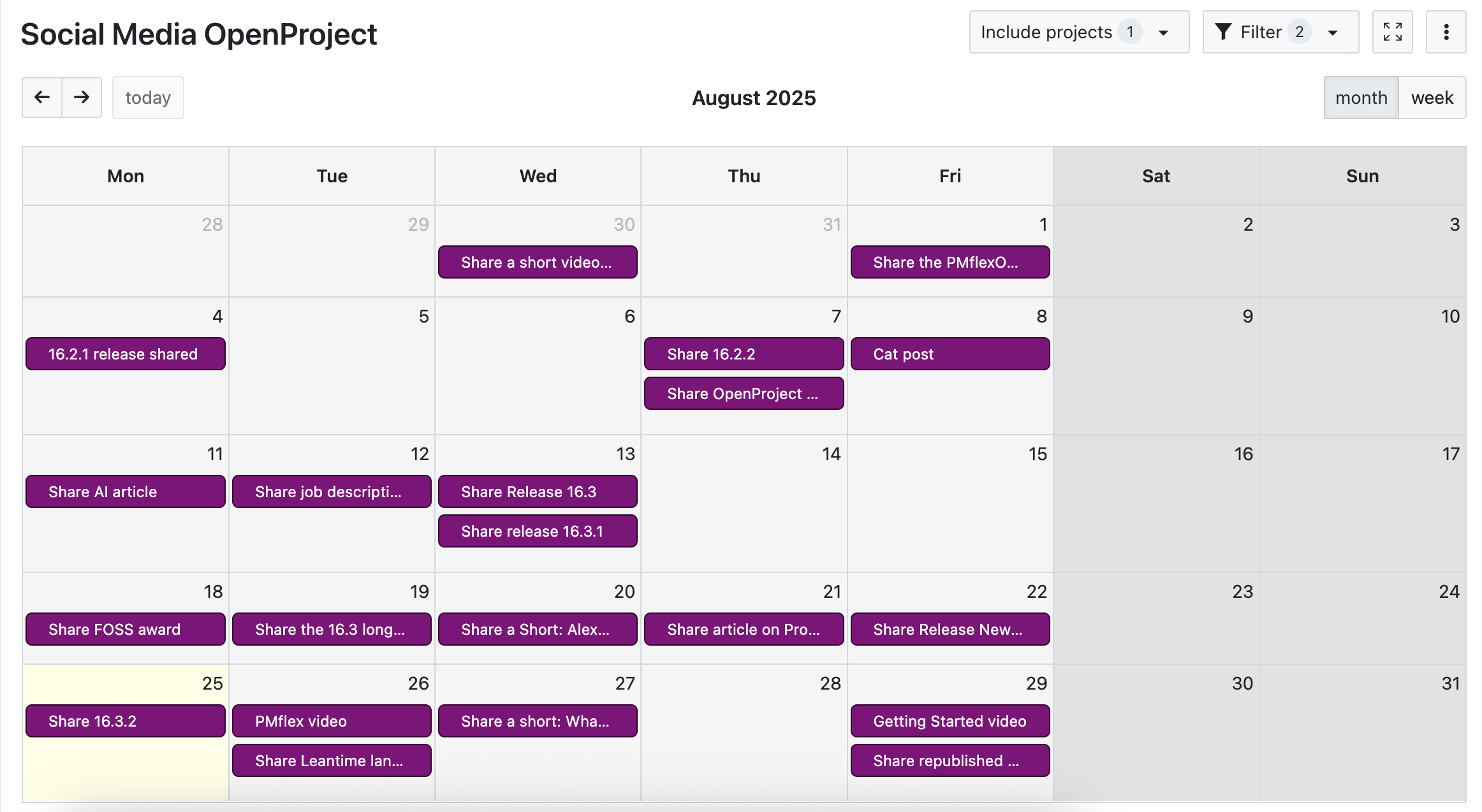
- Add relations between social posts and the content they support (e.g. a blog article or campaign). That way, you always see which social activities belong to which main content pieces.
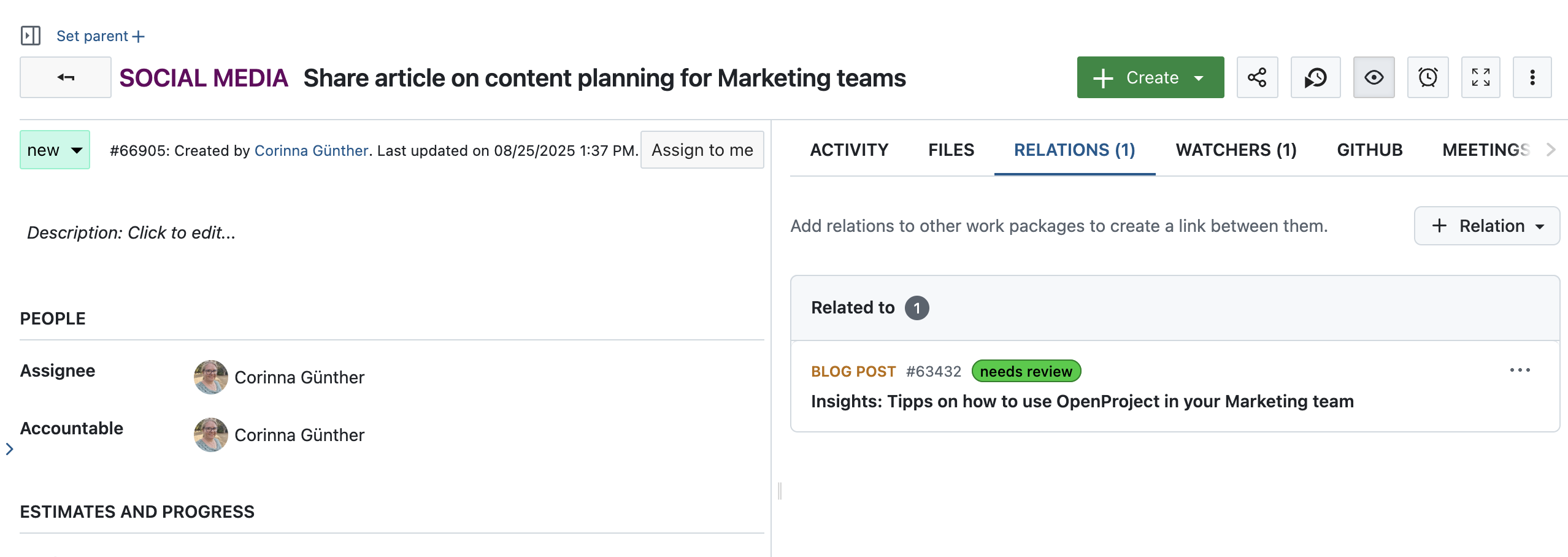
- Assign responsibilities and collaborate in the comments to finalize your posts. You can also assign the whole team if you don’t know yet who will take care of it.
Event and campaign management
At OpenProject, we actually don’t run many marketing campaigns or large-scale events — but we know how crucial structured coordination can be for teams that do. Especially when multiple parties are involved, things can get messy fast without a clear system.
That’s where OpenProject’s flexibility really helps: You can create a dedicated subproject for each event or campaign. This allows you to keep your planning structured, define specific settings, and even invite external stakeholders or agencies without giving them access to your full Marketing workspace.
Meeting management
Need to align schedules, assign tasks, or review campaign materials? Use the Meetings module to prepare agendas and capture outcomes. This helps not only with event preparation, but also with recurring internal check-ins or retrospective meetings.
Tip
At OpenProject, we use our own Meetings module for regular 1:1 meetings between the team lead and content manager. The content manager simply adds the work packages they’re currently working on or need to discuss — and a meeting template ensures all sessions follow a consistent structure. This is what we mean by keeping “everything in one system”.

Team collaboration beyond your marketing team
OpenProject is the perfect choice for open-minded and clever marketing teams who want to customize a content planning tool to their exact needs. From managing blog articles and planning social media posts to coordinating campaigns, events, and team meetings — everything stays in one place, structured and transparent. You define the workflow, the content types, and the collaboration setup.
Marketing teams are often the first to structure their work, but rarely the first to get the tools they deserve. OpenProject helps you take the lead by offering a free content planning tool: streamline your content workflows, collaborate efficiently with other teams, and set an example for transparent, organized work across your organization.
Show what smart teamwork looks like. Become the blueprint for how your company gets things done.
Start your free trial today
You’re probably not reading this just out of curiosity. You’re managing campaigns, chasing approvals, and trying to bring order to creative chaos. We’ve been in the same spot, and that’s why we built this setup for ourselves. If it works for us, it could work for you too.
You know that every good article ends with a call to action, and here’s ours: Start your free trial today. No credit card, no phone number, no pressure. After 14 days, it’s entirely your call whether to continue — but we believe OpenProject will speak for itself.




